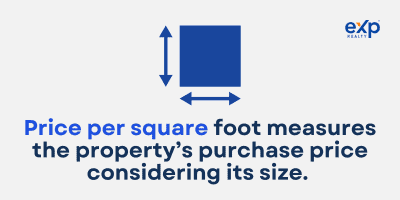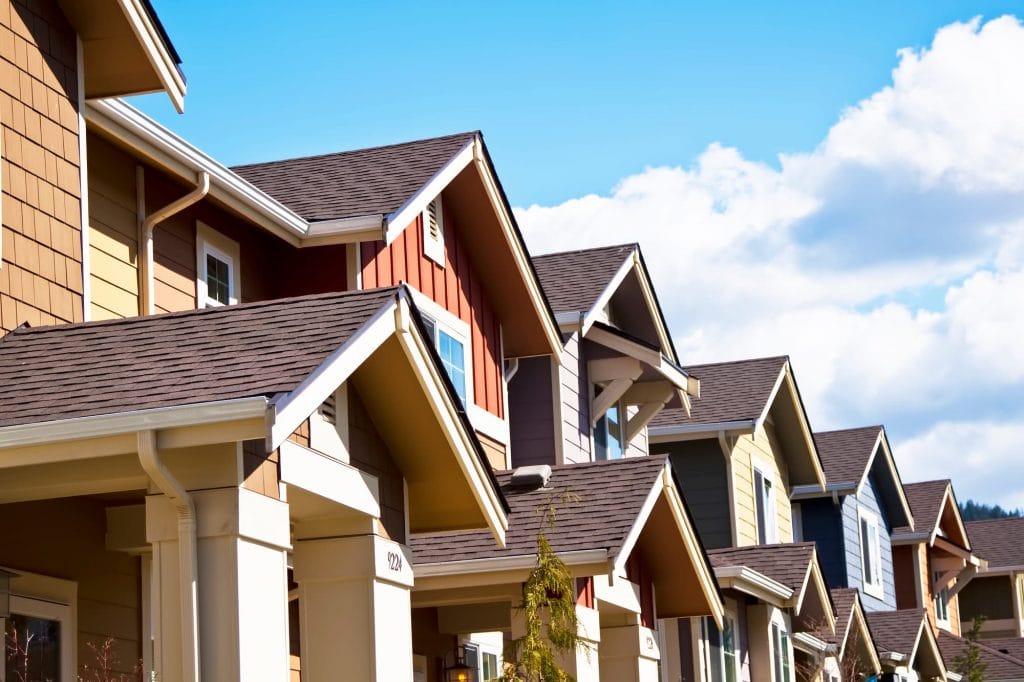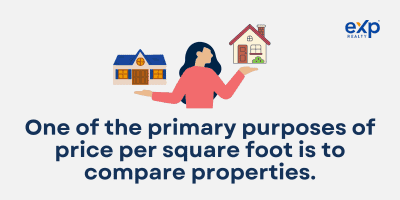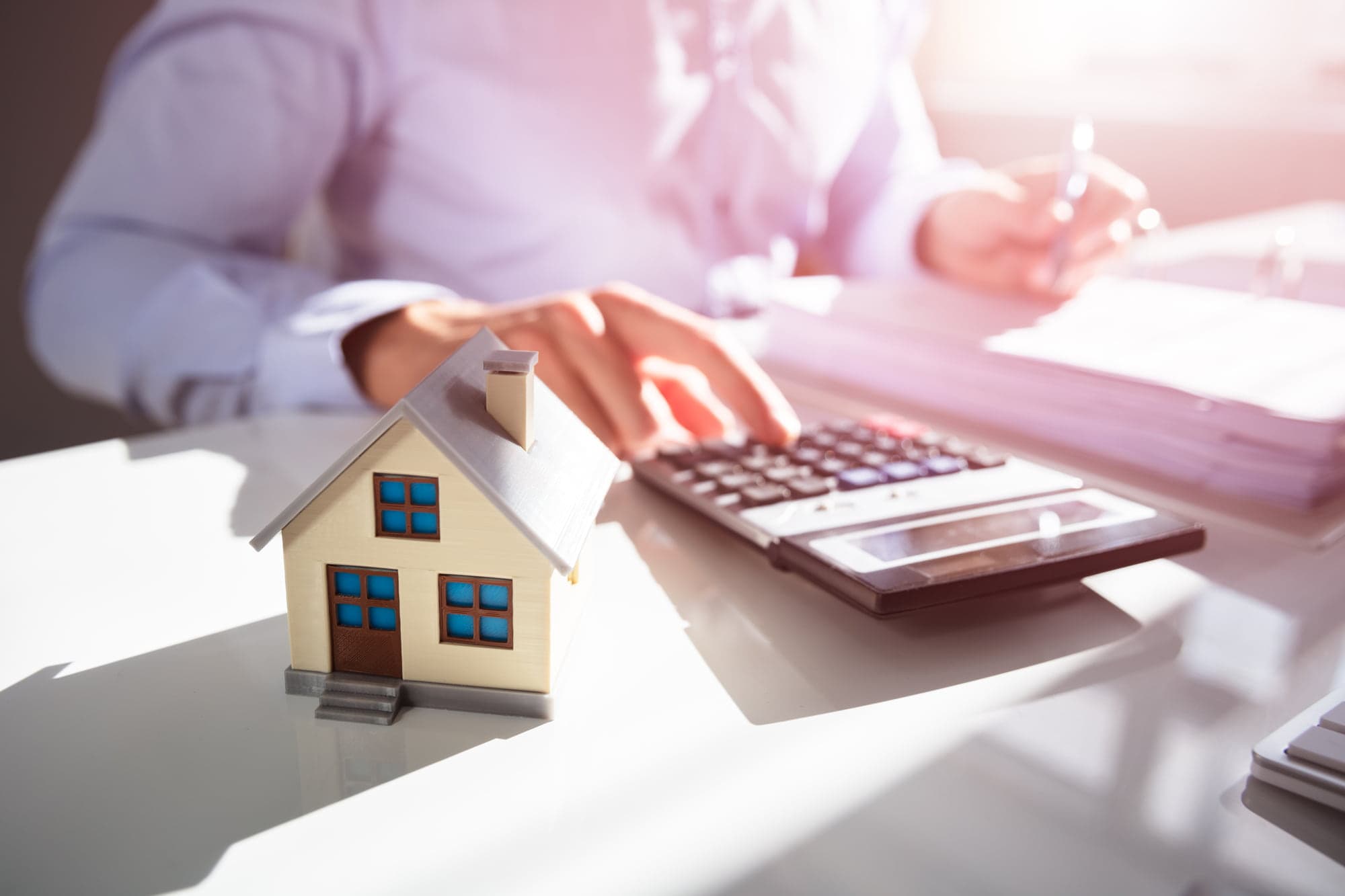Purchasing a house can be a significant step and a huge investment. That’s why it’s essential to understand which elements affect the property’s value. One such element is the price per square foot, which measures the property’s purchase price considering its size.
In this article, we will go through what price per square foot is, how it’s calculated, and the factors that impact it. We’ll also discuss the benefits and challenges of using it and provide tips on integrating it into your home-buying process. Lastly, we’ll emphasize the need for working with a real estate agent to understand more about the price per square foot of properties.
What Does “Price per Square Foot” Mean?

Price per square foot is used mainly by people in the real estate industry to estimate the value of a property or house’s cost. They derived it by dividing the property’s price by its square foot area. Price per square foot area offers a way of comparing the costs of properties of different sizes and geographic locations.
Price per square foot area = Total price of the property / total square area
For instance, if the property costs $700,000 and the site is 3,500 square feet, the price per square foot will be $200 ($700,000/3,500 square ft).
A good understanding of price per square foot is important for buyers as it allows them to compare the cost of properties with different areas more accurately. Using the price per square foot, they can easily compare a property’s value in a high-end neighborhood and one in a lower-end community.
Furthermore, it’s a tool for identifying potential bargains or overpriced properties. If a property has a higher price per square foot than other properties in the area, it’s overpriced. The opposite also makes it a good bargain.
Factors That Impact Price per Square Foot
Price per square foot differs from one to another depending on various regional factors. Understanding these factors is vital so that homebuyers can make good purchasing decisions and estimate the cost of homes. These factors include the following.
Urban and Rural Areas
Differences in cost of living and real estate prices vary widely between urban and rural areas. Homes for sale in urban areas usually have a higher price per square foot than those in rural areas. This is because the cost of living and property prices are generally higher in urban areas than in rural areas due to more demand for land. Rural areas have more available land for development.
Neighborhood and Location

Variations in property prices also vary based on neighborhood and location, such as proximity to city centers, coastal location, or desirable amenities. Properties in desirable areas, like being close to city centers, a good school district or with good amenities, like parks, have a higher square footage price.
Home Styles and Building Codes
Dissimilarities in home styles, building codes, and local zoning regulations have a big impact. Building codes and zoning regulations differ according to geographical location. This impacts the type of properties built in that area and their estimated value.
For example, places with stricter building codes, like the San Francisco Bay Area have a high price per square foot due to the higher quality of construction. Also, some architectural styles can be prevalent in some places and costly to construct, ultimately increasing the price per square foot.
Land/Development Costs
Inequality in land and development costs, taxes, and insurance rates all vary between regions. Different areas have different land and development costs, taxes, and insurance rates.
This affects the overall price per square foot. Areas with higher taxes have a lower price per square foot due to higher ownership prices. Also, places with more expensive building materials and labor will lead to a higher square foot costs.
Local Economic Conditions
Effects of local economic conditions, such as unemployment and population growth, can change the average price of housing. Local economic conditions, such as unemployment and population growth, can affect the demand for particular houses while also affecting the price per square foot.
For example, areas with many available job opportunities and a higher population usually have a higher price per square foot because of more demand from homebuyers. On the other hand, places declining economically will have a lower square foot pricing due to having lesser demand for land there.
A good understanding of regional factors that affect a property’s price per square foot is essential when looking at properties. It also ensures that homebuyers pay the appropriate amount when buying any type of property.
The Pros and Cons of Using Price per Square Foot
Real estate agents widely use the price per square foot as a metric. Like any other thing, it has advantages and disadvantages that should be considered before using it. Advantages of using price per square foot include:
- It allows for the comparison of different properties. Price per square foot plays a major role in comparing other properties of different sizes and architectural styles. This makes it easier to compare and contrast various properties for sale when buying and make an excellent final decision. For example, a luxury apartment in an urban place should only be compared to another luxury apartment in that place and not other lower-end ones.
- It helps determine market value. If you know the price per square of a particular property, you easily estimate its market value. Real estate professionals look for the price per square of similar-looking developments in the area and assess the value of the development they are selling.
- Price per square foot can be used in negotiations between buyers and sellers. It’s a common ground during negotiating and helps both parties understand the property’s value.
- Price per square foot provides a starting point for estimating renovation costs. Investors can quickly gauge the renovation cost once they know the price per square foot, as they will know what they are working with.
On the other hand, the disadvantages of using the price per square foot include the following:
- Price per square foot leads to inaccuracies due to regional differences. They usually differ due to living costs, real estate prices, and others, which lead to inaccuracies.
- The price ignores property features and upgrades. For instance, a property with higher-end finishings may have a higher price per square foot than one with lower-end finishings.
- It has limited usefulness in highly diverse real estate markets. Price per square foot is helpful in markets with variety in style, age, and features. In these cases, other standardized tools can be used in analyzing properties and performing square foot calculation.
- Price per square foot may not reflect overall value. It also determines the value of a property according to its size. It doesn’t account for factors like location of the living space, amenities, and condition of the property.
How Price per Square Foot Is Used in Real Estate

One of the primary purposes of price per square foot is to compare properties. Using this standardized tool, real estate professionals can easily compare properties of various sizes, architectural styles, and geographical locations while doing real estate sales.
For example, if two similar properties are different in terms of dimensions, the price per square foot can be used to know whether the bigger property is appropriately priced compared to the smaller one.
Another use can be determining the market value of a property. Real estate professionals will evaluate the property’s market value by looking at the price per square foot of similar properties in the area.
Price per square foot is mainly used during negotiations. In a negotiation where a buyer is confused between two similar properties, they can bargain for a lower price. The seller can similarly also bargain for a higher one.
Additionally, it can be used to estimate renovation costs. Real estate professionals can estimate renovation costs per square foot by looking at the price per square foot of similar properties in the area.
Tips on How to Use Price Per Square Foot in Your Home Search
Integrating price per square foot in your home search has been proven to be quite valuable. Here are some tips on how to do that:
- Gather information on price per square foot. To be able to use price per square foot, you need to have all the information you could ever need about it. You can find this information in online active listings or by consulting real estate agents. You should only compare similar properties in size, location, and amenities.
- Evaluate properties based on price per square foot. Once you have the information that you need, you can use it to evaluate properties. Use it to compare and contrast similar properties in the same neighborhood. This will help you ensure that the list prices are set fairly.
- Apply price per square foot in your home search. You can use it to filter your search result. You can set a minimum or maximum cost per square foot to see properties within your budget.
- Consider other factors. Price per square foot only factors in size. You must look into other factors like location, condition, and property features, ultimately affecting its value.
- Work with a real estate agent. They will guide you through each step of the home search process and give you insights about the price per square foot you might be interested in. They will also help you negotiate for a fair price and evaluate properties.
Key Takeaways

In conclusion, price per square foot is a valuable tool for evaluating a property’s value based on size. It allows one to compare different properties, estimate their market value, and use them while negotiating. However, don’t forget about regional factors that affect the value of a property. It’s also essential to work with a real estate agent to have accurate information about the price per square foot and make proper decisions.
If you’re looking to buy a property, no matter if you’re after small condos or larger homes, look up for eXp properties you would like to purchase and sign up for alerts of new listings when they come on the housing market.
You can further contact a real estate agent that will guide you through the buying process by determining properties’ price per square foot and offering other needed information. By using these resources and working with a knowledgeable agent, you can make informed decisions and find a property that meets your needs and budget.
FAQs: Price Per Square Foot
Is price per square foot important?
Price per square foot is paramount when estimating the value of a property. It further allows you to compare similar properties in the same neighborhood.
How do I reduce the price per square foot?
You can reduce the price per square foot by negotiating with the seller, buying houses in rural areas, choosing a smaller place, or reducing construction costs.
What is the rule of thumb for price per square foot?
The rule of thumb for price per square foot differs in location, architectural type, and condition of the house. Generally, the price per square foot should be 10% of the area’s median price per square foot.
How do you calculate the cost per square foot?
Price per square foot area = Total price of the property / total square area
For instance, if the property costs $700,000 and the site is 3,500 square feet, the price per square foot will be $200 ($700,000/3,500 square ft).
How accurate is price per square foot?
Price per square foot is beneficial but may not always be accurate. Regional differences like property features and upgrades can affect its accuracy.
Is it cheaper to buy or build?
When choosing between buying or building, you must factor in location, materials, and labor costs. Sometimes it’s cheaper to buy and sometimes to build, depending on the situation.
What is price per buildable square foot?
The price per buildable tool calculates the expense of building a new property. It factors in land, material, and labor costs.
What is the cheapest type of house to build per square foot?
The cheapest type of house to build per square foot depends on the location, property features, and property condition. Usually, simple and tiny houses are cheap to build.
Why appraisers don’t use price per square foot?
Appraisers must consider many factors when estimating a property’s value, like the location, condition, and features. The price per square foot does not accurately reflect the property’s value. Therefore, appraisers cannot rely on it alone.





